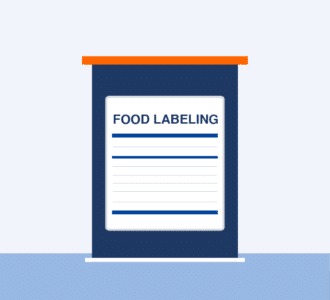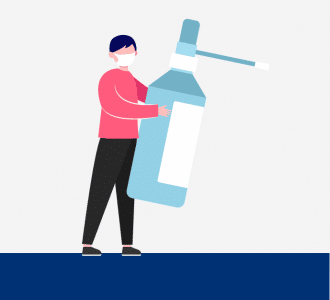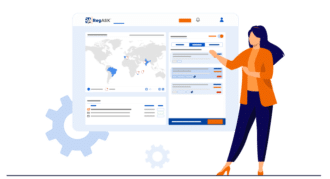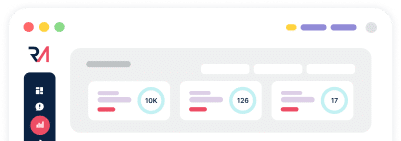According to the OECD, regulations are indispensable to the proper functioning of economies and societies. They underpin markets, protect the rights and safety of citizens and ensure the delivery of public goods and services[1].
The food, drug, personal care, and cosmetics industries are some of the most heavily regulated sectors in the world. This is due to the will of governments and regulators to protect the life and well-being of consumers. Many people have allergies or adverse reactions to certain food or cosmetics, therefore labeling regulations are essential for ensuring that people know what they are consuming and whether the products can be consumed safely.
Every year the United States Food and Drug Administration (FDA) issues hundreds of guidance documents and regulations regarding different aspects of the food and drug industry, including product labeling requirements. In 2021, the FDA published 647 documents, including 58 rules, 13 proposed rules, and 576 notices, at least 19 of them are related to the labeling issue[2].
FDA is just one example, authorities in other countries and regions also put in place hundreds of thousands of new or changing regulations, standards or guidelines including regulatory labeling and product compliance requirements regularly.
Download the article
hbspt.forms.create({region: “na1”,portalId: “20908020”,formId: “f2819e6c-94fd-455a-a891-040b239f7fc6”});
By clicking Download you agree to the privacy policy.
Need help with labeling compliance? Get in touch with RegASK experts
Because these regulations can be quite lengthy and complex, they can be difficult to keep up with, mounting the pressure on product manufacturers. To assist companies in addressing their concerns on regulatory labeling compliance, we will cover in this article the different labeling regulations in key countries and provide best practices for companies in the FMCG industry.
This article consists of the following sections:
- The importance of product labeling compliance

- Key labeling regulations and guidelines on food products
- Labeling requirements during the COVID-19 pandemic
- Best practices to ensure regulatory labeling compliance
- Common mistakes in regulatory labeling compliance and how to avoid them
- The future and emerging trends of labeling regulations
- Regulatory labeling compliance services by RegASK
The importance of product labeling compliance
Labels are used on products for many different purposes, but there are three main reasons why labels are used:
- To identify a product and provide information about it
- To provide instructions for using a product
- To provide warnings about potential hazards of using a product
In the food and beverages industry, labels provide buyers with important information about the products they are eating, such as the ingredients, nutrition facts, allergen concerns, sugar content or alcohol content etc.
In the drug industry, labels show you the active ingredients, dosage and administration, what kind of side effects to expect when taking the drug products and how to use them properly. Cosmetic labels have a principal display panel that includes certain information about the product such as its name, manufacturer, ingredients, directions for use, and warnings about potential risks associated with its use.
Such information is crucial for the safety and well-being of consumers. Insufficient labeling or failure to comply with labeling regulations can put consumers’ health at risk and cause serious consequences. In July 2016, Natasha Ednan-Laperouse, 15 years old, died from allergic reactions to hidden sesame seeds contained in a baguette bought from a Pret a Manger shop at Heathrow Airport. Natasha was unaware that the baguette she ate contained sesame seeds as the Pret a Manger’s allergy labeling was inadequate[3].
Following the death of Natasha, a new allergen labeling law, also known as Natasha’s Law, came into force in the UK in October 2021, requiring businesses to label all food that is prepacked for direct sale with a full list of ingredients[4].
The U.S. FDA also has a set of guidelines for consumer goods manufacturers to follow when labeling their products. Companies failing to comply with labeling requirements can lead to a product recall or civil penalty, which can have a significant impact on a company’s reputation. For example, under the Food and Drug Administration Amendments Act of 2007 (FDAAA), if a company fails to include a mandatory label or put a false or misleading label on its product, they can be fined up to $250,000[5]. Therefore, labeling is an important part of a FMCG company’s marketing strategy and can contribute to the success or failure of the business.
Need help with labeling compliance? Get in touch with RegASK experts
Key labeling regulations and guidelines on food products
In this section, we provide an overview of key labeling regulations and guidelines on consumer goods to help you understand the global labeling regulatory landscape.
United States
Major labeling requirements are outlined in the Federal Food Drug and Cosmetic Act (FDCA), a federal law that regulates food, drugs, medical devices, cosmetics and radiation-emitting devices. The FDCA was enacted in 1938 to protect consumers from fraudulent or misleading label claims about foods or drugs. This law and its amendments are the foundation of all labeling requirements in the United States. It is an extensive document that outlines requirements for labeling food products with ingredients list, nutritional information, net contents, drug labeling requirements and much more. More labeling and packaging regulations and requirements can be found on the FDA website[6] and the National Institute of Standards and Technology website[7].
Canada
In Canada, the labeling requirements on food products are set out in the Food and Drugs Act, Food and Drug Regulations, and other food-related regulations[8], while labeling requirements on non-food products are outlined in the Consumer Packaging and Labeling Act and Regulations[9].
European Union
The European Commission has a list of legislation and guidance requiring companies selling food or beverages in the EU to “provide essential information so that the end consumer can make an informed decision on their purchase.”[10] Detailed requirements are included in the:
- Regulation (EU) No 1169/2011 of the European Parliament and of the Council of 25 October 2011 on the provision of food information to consumers[11]
- EU guidance on food labeling legislation[12], and the
- European Commission health and food safety portal – food labeling[13]
United Kingdom
Food Businesses in the UK must follow The Food Information Regulations 2014, and Regulation (EU) No 1169/2011 to give information on the labels about the food they produce, sell and serve[14]. More information about labeling requirements is available on the UK government website – Food labeling and packaging[15].
Australia and New Zealand
The Food Standards Australia New Zealand (FSANZ), a statutory authority in the Australian Government Health portfolio, sets food labeling standards in the Food Standards Code which are enforced by the Australian states and territories and, in New Zealand[16]. Companies can find more information on a range of labeling topics on the FSANZ website.
China
In China, food labeling is governed by the General Standard for the Labeling of Prepackaged Foods[17] and General Rules for the Nutrition Labeling of Prepackaged Foods (GB 28050-2011)[18].
Singapore
The food labeling requirements are included in the:
- Sale of Food Act[19]
- A Guide to Food Labeling and Advertisements[20]
- A Handbook on Nutrition Labeling[21]
Labeling requirements during the COVID-19 pandemic
Labeling requirements can change during a pandemic or other emergency situation due to temporary regulatory changes, supply chain disruptions, as well as other factors that affect production. For instance, on May 22, 2020, the U.S. FDA issued, with no warning, a guidance document titled “Temporary Policy Regarding Certain Food Labeling Requirements During the COVID-19 Public Health Emergency: Minor Formulation Changes and Vending Machines.” The new temporary guidelines allow manufacturers facing supply chain shortages amid the COVID-19  pandemic to make ingredient substitutions without changing food labels[22].
pandemic to make ingredient substitutions without changing food labels[22].
A similar measure was observed in Canada. Amendments to the Food and Drug Regulations related to nutrition labeling were published on December 14, 2016, and the food industry was given a 5-year transition period to make the changes, which ended on December 14, 2021. However, due to the COVID-19 pandemic, the food industry has asked for more time to meet the new requirements. The Canadian Food Inspection Agency (CFIA) decided to delay the enforcement of the changes and focus its efforts on education and compliance promotion for the first year, until December 14, 2022[23].
Best practices to ensure regulatory labeling compliance
Regulatory labeling Compliance is a process that requires careful planning and attention to detail. Achieving regulatory labeling compliance to the regulations and standards is not an easy task, but it is necessary and critically important for business success. The goal of this section is to provide an understanding of some best practices for FMCG companies to achieve regulatory labeling compliance. These best practices are designed to help compliance and regulatory affairs professionals, industry groups and companies in the FMCG industry adhere to regulations efficiently and effectively.
1. Monitoring and understanding the regulations
The first step in achieving labeling compliance is monitoring and understanding the regulations themselves. This involves examining what food, drug it is and which type of regulation applies and how it applies to a particular situation. Once fully familiarized with that regulation and its interpretation, you can design your labeling process accordingly to ensure maximum compliance with it.
2. Working with the right stakeholders and coordinating cross-functional efforts
Labeling regulations and guidelines often involve different business units and functions across locations and geographies. This makes labeling management a complex, dynamic, and interactive process that requires collective efforts from all functional areas. To get the right stakeholders in on time, it’s important to determine what entities will be involved and their roles. It’s recommended that you have a cross-functional team structure in place that includes:
- The regulatory affairs team that manages all of the regulatory aspects of the labeling compliance program and
 pushes for a central regulatory process
pushes for a central regulatory process - The quality assurance team that ensures product safety and quality standards are met from start to finish
- The risk management team that analyzes data input by other teams and recommends changes as necessary
- The marketing team that aligns labels with corporate brand standards
A labeling compliance program that takes into consideration the needs and goals of different departments helps meet regulatory requirements while also fulfilling business objectives.
3. Creating a centralized labeling system
The regulatory affairs team shall be responsible for centralizing labeling-related activities, data, policies, and procedures to streamline the process and ensure labeling consistency. Centralization of labeling compliance management will help reduce the gap between the different departments or production units and improve efficiency by managing regulatory affairs from one place. For example, for a product that is divided into four different categories with various regulatory requirements, consistency in label formats will allow the manufacturer to take a central approach and not have to deal with each regulatory body separately.
4. Applying the right tools and solutions
There are many labeling solutions on the market that can help companies with traceability, compliance, and accessing the right legislative sources. However, it is important to know what you want your labeling solution to do for you before investing in one. An external consultant or an expert can help determine which type of labeling solution would work best for your company’s needs. They can also help with implementation and training. Ask RegASK if you need help in choosing the right labeling solution for your business, or even faster, fill out this form with your scope and get a free quote to respond to your compliance needs.
5. Evaluating and continuously improving the labeling system
It’s important to monitor the progress of your labeling system by continuously evaluating how well it’s meeting your regulatory goals. You can do this by asking yourself the following questions:
- What are the benefits of the system?
- Are any of my key stakeholders unhappy or not participating in the system as much as they should be?
- Do I need to revise anything in my compliance procedures?
Common mistakes in regulatory labeling compliance and how to avoid them
The U.S. Department of Agriculture’s Food Safety and Inspection Service has published some common labeling mistakes that companies make and how to avoid them. We hope to help readers grow their understanding of the topic by covering the five most common mistakes. So, if you’re looking to avoid costly mistakes when it comes to ensuring regulatory labeling compliance, read on.
| No. | Common Mistake | How to Avoid Them |
|---|---|---|
| 1 | Label is un-readable. | Ensure labels are clearly printed and large enough to read and that there is proper contrast between the printing and background, avoid poor quality printing or bad design. |
| 2 | The label is incomplete, or information is missing. | Check applicable regulations to make sure all mandatory information is included on labels. |
| 3 | Product standards are not met. | Make sure to comply with the regulatory standards and the requirements. If you are not sure what actions are needed, Ask RegASK. |
| 4 | Ingredients statements or nutrition facts are incorrect. | Ensure the accuracy of the information included on labels. |
| 5 | Nutrient content claims are incomplete or do not comply with regulatory requirements. | Have a good understanding of regulatory requirements and make sure that claims are aligned with what regulators are asking for. |
Source: Food Safety and Inspection Service, U.S. Department of Agriculture[24]
The future and emerging trends of labeling regulations
Just like any other industry, regulatory labeling compliance has also been evolving with time. This section provides an overview of some of the key emerging trends in order to give a clearer picture of where regulatory labeling compliance trend is headed. Using RegASK’s proprietary technology RegInsight, we observe these emerging trends in regulatory labeling:
- The increase in global trade has created a need for more translations of labels into different languages for different regions.
- The shift to eCommerce and online shopping must be taken into account when designing labels. For instance, new research has found that “online food retailers do not consistently display nutrition information on their websites, and U.S. laws are lagging behind in mandating the same labeling online that is required for foods sold in brick-and-mortar stores,”[25] businesses that respond quickly to such gap and demand will be in a better position to manage potential risks and grab opportunities.
- With emerging technologies such as AI and machine learning, there is a significant increase in the use of smart labeling solutions that can automatically generate labels with minimal human input, saving time and cutting costs.
- Regulatory labeling requirements on sustainability, recycling, and environmental impacts and vegetarians have increased and become more detailed as ESG rises on the agenda of regulators, investors, and consumers.
- A more inclusive, agile, and configurable labeling system is needed to allow companies to integrate their labeling requirements and practices across their supply chain. This not only ensures supply chain compliance but also enhances supply chain resilience.
Regulatory labeling compliance services by RegASK
With Ask RegASK, RegASK provides expert regulatory services to help companies build and maintain a strong regulatory strategy to stay compliant with international and local regulations. Whether product development, portfolio repositioning, or maintaining registration, our team streamlines the compliance process and takes away repetitive and time-consuming tasks for you. Our labeling experts have helped hundreds of companies from all over the world get their labels successfully approved and stay compliant. We support you in all aspects of product labeling such as:
- Analyzing labeling requirements in your target markets

- Labeling documents preparation and application for approval
- Dossier submissions
- Monitoring registration deadlines and renewal submissions
- Label and formulation compliance
- Compliance assessments for SKU-specific or non-SKU-specific products
- Ensuring regulatory labeling compliance throughout your entire product lifecycle
- Detecting and interpreting regulatory changes that impact your product labeling
- Providing advisory on how to address a potential lapse in FMCG product labeling compliance
If you’re looking for help with labeling, you’ve come to the right place. From initial assessment to understanding the regulations, acquiring FDA approval, and building a labeling strategy for your product, we do it all. We’ll work with you every step of the way and help you turn your product into a success story!
Need help with labeling compliance? Get a quote from RegASK experts.
Receive a quote in a few clicksReferences:
[1] OECD: Regulatory Policy and Governance
[2] FDA: 2021 Federal Register Index
[3] Pret allergy death: Parents welcome Natasha’s allergy law
[4] Allergen labeling changes for prepacked for direct sale (PPDS) food
[5] US FDA: Regulatory Information about Biologics Advertising & Promotional Labeling
[6] FDA: Food Labeling & Nutrition
[7] Compliance FAQs: Packaging and Labeling in the US
[8] Government of Canada: Labeling Legislative Framework
[9] Government of Canada: Packaging and labeling requirements
[10] European Union Food labeling rules
[11] Regulation (EU) No 1169/2011 of the European Parliament and of the Council of 25 October 2011 on the provision of food information to consumers
[12] EU guidance on food labeling legislation
[13] European Union Food labeling rules
[14] City of York Council: Food Labeling and Food Allergens
[15] GOV.UK: Food labeling and packaging
[16] Food Standards Australia New Zealand: Food labeling
[17] National Standard of the People’s Republic of China
[18] China: China Notifies Revised Draft National Food Safety Standard of General Rules for Nutritional Labeling of Prepackaged Foods
[19] Singapore Sale of Food Act
[20] Singapore Food Agency (SFA): A Guide to Food Labeling and Advertisements
[21] Singapore Health Promotion Board: A Handbook on Nutrition Labeling
[22] Questions and Answers on FDA’s Temporary Policy on Food Labeling Changes During the COVID-19 Pandemic
[23] Government of Canada: COVID-19 Food labeling support measures

